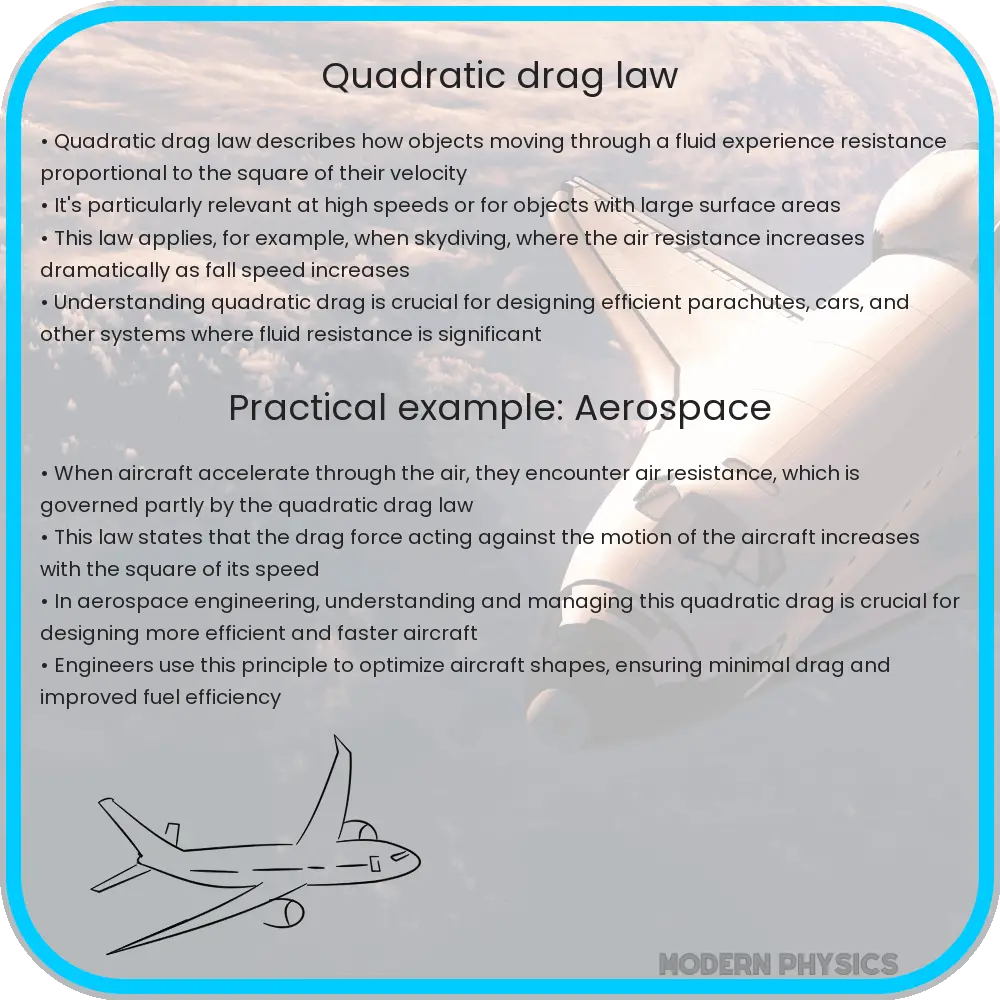Learn about the quadratic drag law, which describes how drag force on an object in fluid increases with the square of its velocity.

Understanding Quadratic Drag Law: Fluid Resistance and Flow Dynamics
When objects move through a fluid, whether it’s air, water, or any other fluid medium, they often encounter a resistance known as drag. Drag is a force that opposes the motion of an object through a fluid, playing a crucial role in various applications ranging from vehicle design to sports science. One specific type of drag that becomes increasingly significant at higher velocities is described by the quadratic drag law.
Basics of Quadratic Drag Law
The quadratic drag law states that the drag force (Fd) acting on an object moving through a fluid is proportional to the square of its velocity (v). This relationship can be mathematically expressed as:
Fd = 0.5 * ρ * A * Cd * v2
Where:
- ρ (rho) – is the density of the fluid through which the object is moving.
- A – represents the cross-sectional area of the object perpendicular to the flow of the fluid.
- Cd – is the drag coefficient, a dimensionless number that depends on the shape of the object and the roughness of its surface.
The quadratic nature of the drag force means that as the speed of the object doubles, the drag force increases fourfold, making it an exponentially dominant factor at higher speeds.
Flow Dynamics and the Quadratic Drag Law
In fluid dynamics, understanding the behavior of flow around an object is crucial for analyzing the drag. At lower speeds, where the fluid flow is laminar (smooth and regular), the drag is often proportional to the velocity (linear drag). However, as the speed increases, the flow becomes turbulent, leading to the predominance of quadratic drag.
Turbulence involves complex and chaotic fluid motion, which significantly increases fluid resistance. In this regime, the quadratic drag law provides a more accurate description compared to linear models. This transition from laminar to turbulent flow, and consequently from linear to quadratic drag, is typically marked by a critical Reynolds number (Re). The Reynolds number is a dimensionless quantity used in fluid mechanics to predict flow patterns in different fluid flow situations.
Applications of Quadratic Drag Law
The application of the quadratic drag law is vast and impacts many fields. Here are some common areas where it is particularly useful:
- Aerospace Engineering: In designing aircraft, understanding and minimizing quadratic drag is essential for enhancing performance and fuel efficiency.
- Automotive Industry: Car designers utilize knowledge of quadratic drag to shape vehicles that have reduced drag, leading to higher speeds and lower fuel consumption.
- Sports Engineering: In sports, equipment and apparel design, such as racing suits and bicycles, are optimized based on their aerodynamic properties to minimize drag, enhancing the athlete’s performance.
- Environmental Engineering: In designing wind turbines, engineers must consider quadratic drag to maximize efficiency in energy capture from high-speed winds.
The real-world implementations of the quadratic drag law demonstrate its importance in both practical applications and theoretical studies in fluid dynamics. By understanding how this law operates, engineers and designers can create more efficient systems in a variety of fields.
Impact of Shape and Roughness on Drag Coefficients
The shape of an object and the roughness of its surface play a critical role in determining its drag coefficient (Cd), which in turn affects the drag force experienced. Objects with streamlined shapes typically have lower drag coefficients because they allow the fluid to flow more smoothly around them, reducing turbulence. Conversely, blunt or irregular shapes increase turbulence and result in higher drag coefficients.
Surface roughness can also affect the drag coefficient noticeably. A smoother surface will generally reduce the drag coefficient, while a rougher surface increases it due to greater frictional forces and enhanced turbulent wake. Thus, optimizing both shape and surface texture is a key strategy in engineering to manage and minimize drag effectively.
Experimental Studies and Simulations
Experimental setups such as wind tunnels and fluid flow tanks are commonly used to study and visualize the impact of quadratic drag on different objects. Through these experiments, engineers and scientists can obtain a clearer understanding of how changes in velocity, shape, and fluid properties affect drag.
Alongside physical experiments, computational simulations play a crucial role. Using software like Computational Fluid Dynamics (CFD), researchers can simulate and analyze the drag forces under various flow conditions without the need for physical prototypes. These simulations help in predicting the performance of designs and in making necessary adjustments before actual production or implementation.
Challenges and Future Perspectives
While the quadratic drag law provides a robust framework for understanding and estimating drag forces in fluid dynamics, it faces challenges, especially in highly complex flows or at extremes of velocitiy and fluid properties. Future advancements in computational methods and materials science are expected to lead to better prediction models and more efficient designs with optimized drag characteristics.
Conclusion
Understanding the quadratic drag law is essential for anyone involved in designing objects that interact with fluid environments, whether they are vehicles moving through air or water, or structures exposed to fluid flow. By comprehending the variables of this law—velocity, fluid density, cross-sectional area, and drag coefficient—and their interrelations, designers and engineers can enhance the efficiency, performance, and environmental sustainability of their projects. The continued study and application of quadratic drag not only improve theoretical knowledge in fluid dynamics but also drive innovation across multiple engineering disciplines, demonstrating the profound impact of physics in everyday engineering solutions.
